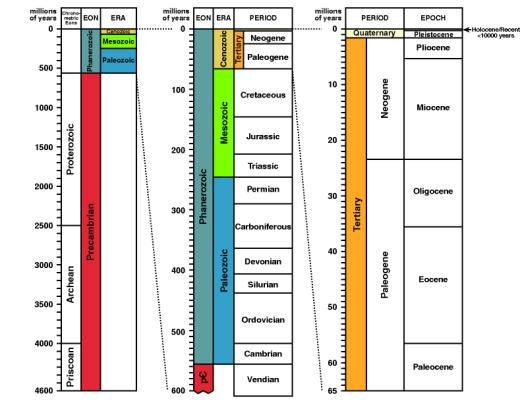|
The Earth's Geologic Events
What Does the Timeline Really Look
Like? Plotting Geologic Events on a Timeline
Purpose
In this activity, you will gain an
appreciation for the span of geologic time and the relative recency of
most of the earth's major historical events.
Introduction
Many people, not just students, have
difficulty grasping the magnitude of the time that has passed since the
Earth formed. It is also a common misconception that major biological
and geological events occurred at regular intervals over this long time
period. This is often because of the way the geologic time periods are
depicted on charts such as the one below. This exercise illustrates
when major events occurred relative to each other, the long periods of
"quiet" between these events and the relative quiescence of the first 4
billion years of Earth's history.

Supplies
Graph paper
Tape
Pencils with erasers
Calculator
PART 1
Instructions
In this activity you will use 100
consecutive squares on graph paper to plot several geologic events.
(GRID SIZE OF GRAPH PAPER IS OF YOUR OWN CHOOSING - WORKS WITH ALL
SIZES AS LONG AS YOU HAVE ONE HUNDRED SQUARES IN A ROW TO WORK WITH.)
You may need to tape more than one sheet of graph paper end-to-end to
get 100 squares in a row.
1. Draw a straight line under 100
consecutive squares on the graph paper.
2. Above the line, place arrows
pointing to the spot on the line that you think corresponds to the
location of the time period of the mentioned activity.
|
 Earth and Moon form Earth and Moon form
|
|
Oceans form 
|
 |
Hydrologic
(water) cycle begins
(weathering and erosion started then)
|
|
 |
Grenville
Orogeny
(formation of the Green Mountains in VT)
|
|
|
Massabesic Gneiss
|
|
 Simple sea life Simple sea life
|
|
Bronson Hill Anticline
(first collision and folding that created New Hampshire's first 'land')
|
|
Concord Granite injected & cooled
|
|
Mt Washington/Chocorua/Monadnock rocks formed
|
|
Ossipee ring dike & dinosaurs 
|
|
Dinosaurs extinct
|
PART 2:
1. For background information,
Geologic Time (the total age of the Earth) is 4.6 Billion years.
2. Calculate the value of one square
in years.
3. Now plot the location of the
following events by placing arrows below the line pointing to the spot
on the line that you think corresponds to the location of the time
period of thementioned activity. (Times are given in billions (bya) or
millions (mya) of years before the present. Therefore, you will be
measuring back from the present each time you plot a point.)
|
Earth and Moon form
|
4.6 Billion years ago ( BYA
)
|
|
Oceans form
|
4.26 BYA
|
|
Hydrologic (water) cycle
begins
(weathering and erosion started then)
|
2.0 BYA
|
|
Grenville Orogeny
(formation of the Green Mountains in VT)
|
1.3 BYA
|
|
Massabesic Gneiss
|
900 million years ago ( MYA
)
|
|
Simple sea life
|
600 MYA
|
|
Bronson Hill Anticline
(first collision and folding that created New Hampshire's first 'land')
|
540 MYA
|
|
Concord Granite injected
& cooled
|
400 MYA
|
|
Mt
Washington/Chocorua/Monadnock rocks formed
|
400 MYA
|
|
Ossipee ring dike &
dinosaurs
|
180 MYA
|
|
Dinosaurs extinct
|
65 MYA
|
|
Humans
|
4 MYA
|
|
Ice age ends
|
10,000 years ago
|
|
Old Man Collapses
|
Evening of May 2-3, 2003
|
|